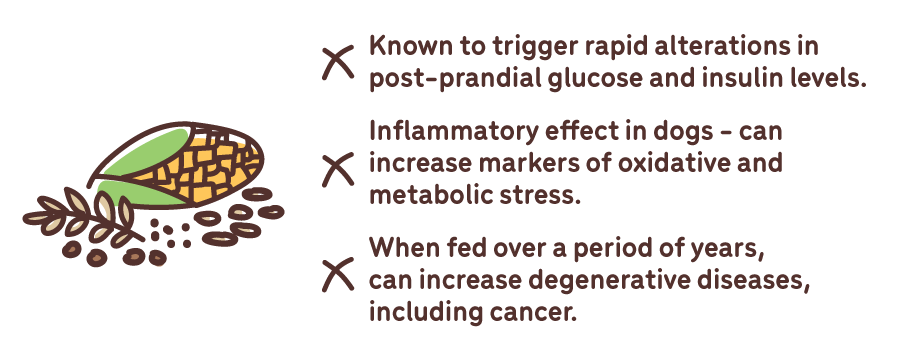The Effects of Processed Carbohydrates on Your Dog

by Narelle Cooke, Canine Nutritionist
Carbohydrates now make up a considerable portion of many commercial pet foods, however, not all carbohydrates are created equal. The further a food is from its natural form and the more it’s processed, the less it retains its healthful nutritional properties. As such, what determines whether an added source of carbohydrate is a good or bad thing in terms of its effect on our dog’s health, is not only determined by the amount and type of carbohydrate, but also the processing method used.

Lets’ explore what this means for our dogs!
Carbohydrate Type 1 - Fresh fruits and vegetables
Many commercial pet foods will have fruits and vegetables listed in the ingredients panel, but the nutritional benefit to your dog will vary greatly depending on the product you choose. And while you might even question the need for plant matter in a dogs’ diet (given that they’re carnivores), dogs have evolved to be able to consume greater amounts of carbohydrate than the wolf (1). and even wolves are known to scavenge for berries and other fresh plant matter as part of their regular diets (2).
Fresh fruits and vegetables provide an amazing array of health benefits for our dogs. For example:
- The enzymes found in fresh produce can aid in the digestive process.
- They contain fibre, which helps to optimise gastrointestinal health.
- They are a rich source of polyphenols and antioxidants that help to strengthen the immune system, support cellular health, reduce inflammation and decrease the incidence of degenerative diseases such as diabetes, arthritis and cancer (3,4).
- They contain health-promoting phytonutrients that our dogs can’t get from muscle meats, organs and bone.
The effects of processing
Fruits and vegetables are an important source of essential nutrients that our dogs need to thrive. These include things such as folate, magnesium, manganese, iron, potassium, vitamin E, the B complex vitamins and a variety of carotenoids (just to name a few). Many of the nutrients that fruits and vegetable contain are highly sensitive to processing, especially with methods that involve heat (5), so for the greatest health benefits to our dogs, they are best consumed fresh or as minimally processed as possible. The nutrients contained in vegetables also become more bioavailable to our dogs when minced or blended.
Raw pet food manufacturers will often include chopped-up plant matter in their products, which are then sold fresh or frozen. In terms of processing, freezing, when properly done, is the method of food preservation that has the least impact on fruits and vegetables, and which preserves the greatest quantity of nutrients (6).
Unfortunately, many pet dogs consume a kibble-based diet and it is estimated that approximately 95% of dry pet foods are extruded (7). In this process, the ingredients are exposed to high temperatures and pressure before being subjected to further drying to remove excess moisture. Given the delicate nature of many compounds in fresh fruits and vegetables, the extrusion process has been shown to be highly destructive for several key nutrients, including the B group vitamins, vitamin A, vitamin C and vitamin E (8).

Metabolic impacts
There is growing evidence that the type of carbohydrate consumed is important in relation to metabolic disease risk (9). Fruits and vegetables, particularly those such as berries and leafy greens, provide our dogs with a great source of low glycaemic carbohydrates that can reduce post-prandial (the period after eating) glucose and insulin levels. This is an important dietary strategy for reducing the incidence of diabetes and associated health complications that are becoming more and more prevalent in our dogs (10,11).

Carbohydrate Type 2 - Legumes & tubers
Grain-free diets are commonly formulated with different types of tubers (i.e. potato, sweet potato, cassava (tapioca), taro, and legumes (i.e. soy, lentils, peas, beans) as replacements for conventional grains. These foods serve as a source of protein, fibre, B vitamins, trace nutrients and starchy carbohydrates. While such ingredients can provide some benefits to our dogs in small amounts, the proportion of these ingredients in many cooked processed pet foods is often significantly higher than what is required nutritionally. This has the potential to create health problems for our dogs due to the fact that plant-based proteins are deficient in several essential amino acids (particularly the sulphur amino acids methionine and cysteine) compared to animal-based proteins, and when present in too high amounts, can increase the likelihood of nutrient imbalances (12).
Because of the increased inclusion of legumes, along with more highly processed ingredients such as potato starch and tapioca starch, the average commercial kibble product is exceedingly high in carbohydrates, often up to 60%. Unfortunately, high levels of starch are necessary in the making of kibble, as it’s the starch that makes the dough sticky and which acts like a ‘cement’ to hold all of the ingredients together.

Effects of processing
While detrimental to the nutrient value of a food, extrusion is necessary for kibble manufacturing as dogs are not able to digest raw legumes and tubers, requiring them to be highly processed. Raw legumes, for example, contain anti-nutritional factors such as phytates, tannins, trypsin-inhibitors and lectins, which inhibit protein digestibility, reduce mineral uptake, contribute to gastrointestinal disturbances and impair overall digestion. Processing at high pressure and temperature acts to denature (break down) the proteins and inactivate the enzyme inhibitors to a certain extent, making them more digestible to our dogs (13). Unfortunately, while making legume proteins somewhat more digestible, the essential amino acids, essential fatty acids and vitamins present in the food don’t fare so well. These key nutrients that our dogs need to thrive are lost or damaged during the manufacturing process, hence necessitating their replacement with synthetic versions.

Metabolic impacts
Starch is not an essential nutrient for dogs and is ultimately broken down into sugar in the body. Chronically elevated blood sugar levels negatively impact our dogs’ health in various ways. To make matters worse, when it comes to what we’re feeding our dogs, the more that starchy carbohydrate sources are cooked (i.e. via the extrusion process), the more rapidly the starch is digested. This can have significant implications on metabolic function, as rapidly digested starches are known to promote high blood glucose and insulin peaks with subsequent fat deposition. This increases the risk for obesity in our dogs along with those diseases that occur as a result of obesity, such as diabetes and heart disease (14).

Carbohydrate Type 3 - Cereal grains
Cereal grains are the seeds that come from grasses such as wheat, millet, rice, barley, oats, rye, sorghum, and maize (corn). The nutrients provided by cereal grains include carbohydrates/starch, protein, fibre, B complex vitamins, vitamin E, zinc, magnesium and phosphorus. Cereal grains play a similar role in commercial kibble as legumes and pose the same potential health risks if fed in too large amounts long term.
Effects of processing
The extrusion process can also improve the protein digestibility of cereal grains whilst simultaneously having a detrimental effect on amino acid and nutrient content. Lysine is the most limiting essential amino acid in cereal-based products and the most reactive to extrusion, with losses of up to 80% reported (13). Such extensive reductions in essential amino acid content immediately results in a decrease in the overall nutritional balance of the food and if the animal protein content is sub-optimal, will require synthetic nutrient fortification.
The Maillard reaction is a chemical reaction between proteins and carbohydrates that generally only occurs above 140 degrees Celsius. Studies have confirmed that the Maillard reaction can contribute to acrylamide formation, the highest levels of which tend to be found in starchy foods like grains and potatoes that have been extruded (15). Acrylamide is classified as a Group 2A carcinogen, and studies on laboratory animals (including dogs) have shown that exposure to acrylamide through the diet greatly increases the likelihood of developing gene mutations and tumours in various organs, neurotoxicity, adverse effects on male reproduction, skeletal muscle weakness, ataxia and developmental problems (13,16,17).
Additionally, cereal grains are often milled (referred to as ‘refined’ grains), a process that removes the bran and germ. This gives them a longer shelf life but strips away most of the key vitamins and minerals, leaving very little nutritional value.(18)

Metabolic impacts
Cereal grains such as rice and corn are known to trigger rapid alterations in post-prandial glucose and insulin levels in both humans and dogs (19,20). Studies have also shown that grains have an inflammatory effect in our dogs and act to increase markers of oxidative and metabolic stress. Unfortunately, low-grade inflammation is often not apparent in the short term, but when foods that trigger inflammation are fed over a period of years, that’s when we see an increase in degenerative diseases, including cancer (20).

Summary
More and more pet owners are asking how pet food is made and questioning its quality and safety. Fruits, vegetables, grains and legumes are all sources of carbohydrate in our dogs’ diet and yet, as you have just learnt, carbohydrates are by no means created equal. Ideally, we want to avoid feeding products high in simple or fast acting carbohydrates that cause rapid spikes in blood glucose, and we should definitely be avoiding any product where ‘sugar’ is listed in the ingredients panel (yes, there are companies that actually add pure sugar to dog food!). What our dogs will benefit from most are those foods with a species-appropriate balance of animal proteins (such as muscle meats and organs), bones, natural sources of omega-3 fats (such as salmon) and low-glycaemic, phytonutrient-rich carbohydrates, such as those found in fresh fruits and vegetables.
If you'd like to know the carbohydrate content in your pets food, check out our carb calculator.
About the Author - Narelle Cooke, Canine Nutritionist.

Narelle is a clinical Naturopath, Nutritionist and Herbalist for both people and pets, and operates her wellness clinic ‘Natural Health and Nutrition’ in Dural, Sydney.
Being a lifelong dog-owner and currently meeting the demands of three French Bulldogs, two German Shepherds and a Burmese cat, Narelle is as passionate about the health and wellbeing of our pets as she is about their owners. And it was this strong desire to see her own pets live their longest and best lives that led her to hours of personal research and additional study in the area of natural animal health and nutrition.
· Bachelor of Health Science(Naturopathy) (ACNT)
· Bachelor of Agricultural Science (honours) (The University of Melbourne)
· Advanced Diploma of Naturopathy (AIAS)
· Advanced Diploma of Nutritional Medicine (AIAS)
· Advanced Diploma of Western Herbal Medicine (AIAS)
· Certificate III in Dog Behaviour and Training (NDTF)
· Certificate in Natural Animal Nutrition (CIVT)
· Certificate in Animal Nutrition (HATO)
